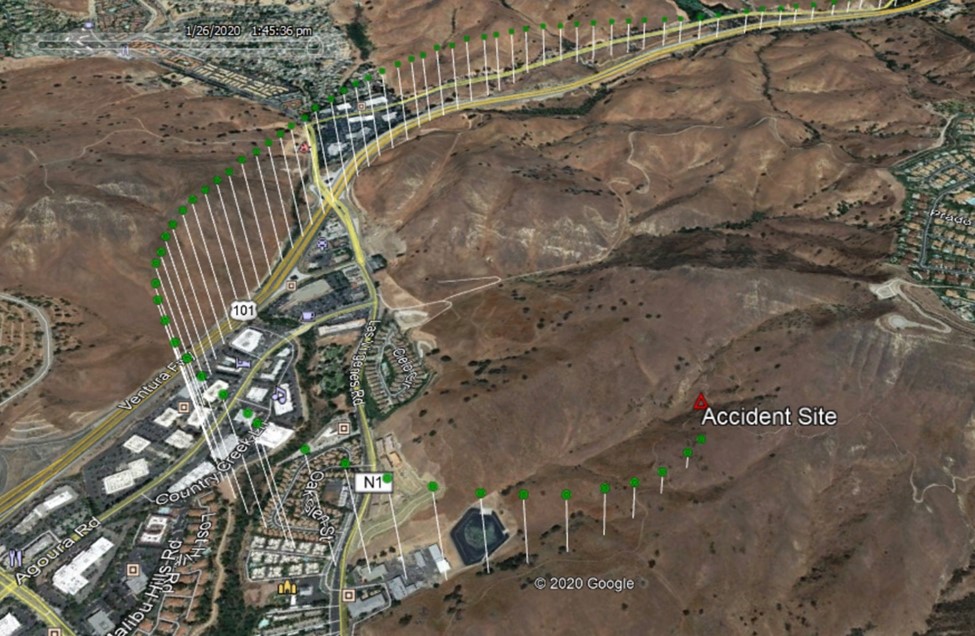Black Hawk Scud Running in Tennessee: IIMC & CFIT (Arista Aviation Services Sikorsky HH-60L N260MW near Tullahoma)
At 15:00 on 28 February 2019, Sikorsky HH-60L N260MW of Arista Aviation Services suffered a Controlled Flight into Terrain (CFIT) near Tullahoma Regional Airport (THA), Tennessee during a ferry flight. A Visual Flight Rules (VFR) flight plan filed, however Instrument Meteorological Conditions (IMC) prevailed at the accident site, suggesting Inadvertent entry into Instrument Metrological Conditions (IIMC).

Wreckage of Arista Aviation Services Sikorsky HH-60L N260MW Outside Tullahoma, TN (Credit: FAA via NTSB)
At this time, three years after the accident, the US National Transportation Safety Board (NTSB) has still only published a preliminary report. On 9 March 2022 however, the NTSB public docket was released. The NTSB explain that:
…the purpose of the flight was to reposition the helicopter for maintenance and inspection.
Part of the purpose of the inspection was to add the helicopter to a specific Restricted Type Certificate for ex-military Black Hawks. There are some indications the helicopter was then due to be displayed at Heli-Expo in Atlanta, Georgia (4-7 March 2019).
The special airworthiness certificate and ferry flight permit were issued for the flight from Enterprise Municipal Airport (EDN), Enterprise, Alabama, to THA, which included a restriction for VFR operation.
The crew were aged 69 and 70, each coincidentally with 6800 flying hours of experience, 2500 on type. They reportedly knew the route well.
According to the pilot-in-command, the crew departed EDN earlier that morning, destined for THA. They had stopped at 4A6 [Scottsboro Municipal Airport, Alabama], which was about 42 miles from the destination, for fuel [paid for at 12:27] and lunch.
Arguably this was a breach of the ferry permit that was for a direct flight from EDN to THA.
He recalled that the weather at that time appeared to be clear. They departed from 4A6 with no issues.
The preliminary report does not state when the aircraft departed Scottsboro. The accident report form however claims it was at 14:00, i.e. an hour before the accident, even though the accident site was only “42 miles from the destination”. According to the preliminary report, the crew planned to fly at 500 ft and…
While enroot [sic] to THA, the pilot recalled that they had encountered weather and were attempting to turn around when the accident occurred.
The accident report form gives more detail (with our emphasis added):
During the flight, approximately ten miles from THA, we encountered severe heavy rain, moderate turbulence, along with rapidly deteriorating visibility.
We descended to approximately 100 feet AGL to maintain visual contact with the ground.
This tactic is known as scud running.
When VFR flight conditions were no longer possible we executed a turn and attempted to land the helicopter in an open field.
Significantly, the accident site was only 2.5 nm from THA, so the helicopter had gotten very close before the decision to turnaround.
The 14:55 weather conditions reported at the THA…included an overcast cloud ceiling at 300 ft above ground level (AGL), visibility 2.5 (statute) miles in mist, temperature 13° C, dew point 12° C. The visibility had reduced to 1 mile at the next recorded observation at 1515.
A review of the graphical aviation forecast issued by the National Weather Service at 13:02 revealed that overcast skies were expected in the area around the time of the accident with cloud bases at 1,100 ft MSL and tops at 9,000 ft MSL.
Furthermore:
Two airmen’s meteorological information advisories were issued at 1200 and 1500, warning of instrument meteorological conditions expected in the area of the accident.
There is no mention of when the crew last checked the weather,
The PIC reported no problems or issues with the helicopter. He did not recall any further details about the actual accident sequence.
A witness located about one-half nautical mile from the accident site was outside her home when she heard the sound of a helicopter nearby. She could not see the helicopter due to the clouds, and she noted that it was raining lightly at the time. She said the helicopter sounded “really loud and low…” She heard the helicopter for about 30 seconds before hearing a loud “whump whump” sound followed by a loud boom.
Crash site VIDEO.
Examination of the accident site revealed:
The fuselage came to rest on its left side and nearly inverted, at the edge of a wooded area. The majority of the tailboom was in an adjacent tree about 30 feet above the ground. The main rotor blades were all separated from the hub, fragmented, and strewn across an area about 100 yards in diameter.

Wreckage of Arista Aviation Services Sikorsky HH-60L N260MW Outside Tullahoma, TN (Credit: FAA via NTSB)
We will update this article when the NTSB issue their probable cause.
Our Observation
HAI have their Land and Live campaign. This feels like another accident where the crew pressed on (Plan Continuation Bias) thinking they could always land en route if it got really bad. s others have reflected this may not be that effective as a safety strategy “as long as VFR helicopters are permitted and even expected to poke around at low altitudes in marginal visibility, some non-zero percentage of them will stray into IMC, and some non-zero percentage of their pilots will be unlucky “. Certainly in this case, with poor weather forecast, not flying would have been a better option.
Safety Resources
The European Safety Promotion Network Rotorcraft (ESPN-R) has a helicopter safety discussion group on LinkedIn.
ESPN-R / EHEST Leaflet HE 13 Weather Threat For VMC Flights:
USHST video 56 seconds to live:
You may also find these Aerossurance articles of interest:
- A Try and See Catastrophe: R44 Accident in Norway in Bad Weather
- Erratic Flight in Marginal Visibility over New York Ends in Tragedy
- BK117 Impacts Sea, Scud Running off PNG
- Sécurité Civile Fatal EC145 CFIT: Night, Low Ceiling and a Change in Route
- Fatal Mi-8 Loss of Control – Inflight and Water Impact off Svalbard
- Canadian Coast Guard Helicopter Accident: CFIT, Survivability and More
- Night Offshore Winching CFIT
- NTSB Report on Bizarre 2012 US S-76B Ditching
- A Short Flight to Disaster: A109 Mountain CFIT in Marginal Weather
- Plan Continuation Bias & IIMC in Kenyan Police AW119 Accident
- Grey Charter in French Guiana: IIMC and LOC-I
- Canadian Flat Light CFIT
- A Lethal Cocktail: Low Time, Hypoxia, Amphetamine and IMC
- Windscreen Rain Refraction: Mountain Mine Site HESLO CFIT
- Usage Related Ex-Military Helicopter Accident
- Wasp Stung By Lack of Lubrication
- Yuma Hawk Accident: Lessons on Ex-Military Aircraft Operation
Calabasas
The NTSB held a board meeting in February 2021 that determined that the pilot’s decision to continue VFR flight into IMC, resulting in spatial disorientation and a loss of control, led to the fatal 26 January 2020 crash of a Sikorsky S-76B helicopter N72EX in Calabasas, California.
The pilot and eight passengers [including baseball legend Kobe Bryant] died when the helicopter, operated by Island Express Helicopters, Inc., entered a rapidly descending left turn and crashed into terrain.
Contributing to the accident was the pilot’s likely self-induced pressure and plan continuation bias, which adversely affected his decision making. The NTSB also determined Island Express Helicopters Inc.’s inadequate review and oversight of its safety management process contributed to the crash.
“Unfortunately, we continue to see these same issues influence poor decision making among otherwise experienced pilots in aviation crashes,” said NTSB Chairman Robert Sumwalt. “Had this pilot not succumbed to the pressures he placed on himself to continue the flight into adverse weather, it is likely this accident would not have happened. A robust safety management system can help operators like Island Express provide the support their pilots need to help them resist such very real pressures.”
Aerossurance has extensive air safety, operations, SAR, airworthiness, human factors, aviation regulation and safety analysis experience. For practical aviation advice you can trust, contact us at: enquiries@aerossurance.com
Follow us on LinkedIn and on Twitter @Aerossurance for our latest updates.


Recent Comments